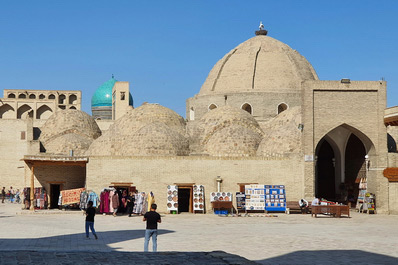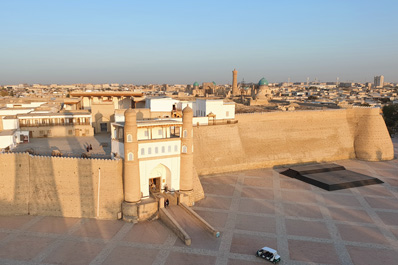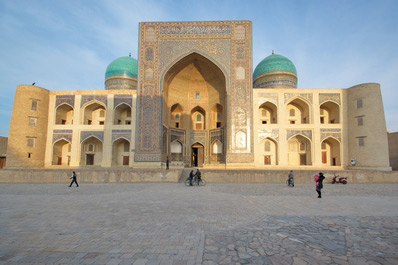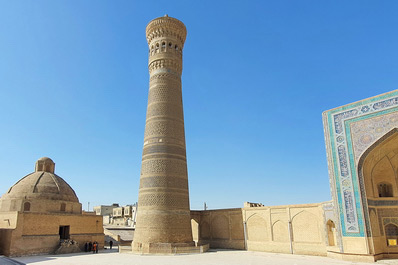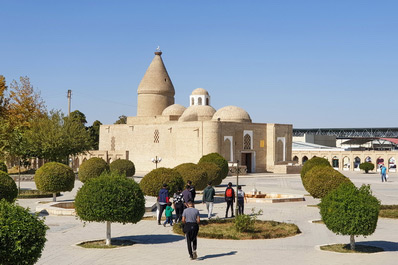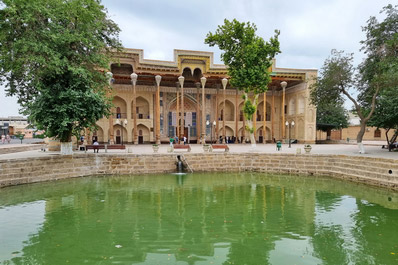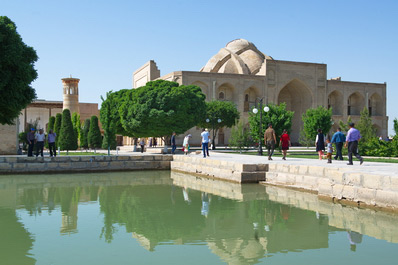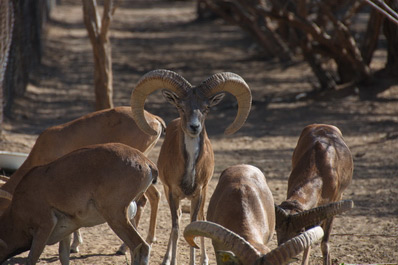Monuments of Bukhara
Bukhara is one of the oldest cities in Central Asia and is rightly known as the pearl of the East. Situated at the crossroads of the Great Silk Road, it has been a hub of trade between distant parts of the world for centuries. Over time, this cultural oasis drew travelers, merchants, and scholars, becoming a thriving center of powerful states and empires. Today, Bukhara is where the past seamlessly blends with the present - every landmark tells a distinct story, highlighting the timeless charm of this remarkable ancient city. In this article, we’ll introduce you to the most iconic monuments in Bukhara that every visitor should experience.
The Lyabi-Hauz ensemble is one of the most atmospheric corners of historic Bukhara, set around a tranquil artificial pond (hauz). The ensemble features several architectural treasures: the XVI century Kukeldash Madrasah, one of the largest in Central Asia; the Khanaka of Nadir Divan-begi, a Sufi monastery adorned with finely carved portals; and the Nadir Divan-begi Madrasah, noted for its striking mosaic panels. Shaded by leafy trees that border the pond, the area is dotted with restaurants serving Uzbek cuisine - a favorite spot for locals and visitors to unwind and soak up the spirit of the ancient East.
The trade domes are traditional covered bazaars located in the heart of Bukhara’s old town. Built in the XVI century, they were the key commercial centers for centuries, reinforcing Bukhara’s role as a vital point on the Great Silk Road. Characterized by their sturdy brick domes, these markets offered a cool and sheltered space for merchants selling all kinds of wares. Four trading domes survive today: Toki-Sarafon, known for textiles and clothing; Toki-Telpak-Furushon, which specialized in headwear; and Toki-Zargaron, home to fine jewelry. The largest passage, Tim Abdulla Khan, was devoted to the trade of silk fabrics and intricately woven carpets, and still impresses with its grand scale, more palace than marketplace. Today, Bukhara’s trade domes remain vibrant, drawing shoppers with their colorful goods and lively oriental bazaar atmosphere.
The Ark Fortress stands as a powerful symbol of Bukhara and ranks among its most significant landmarks. This formidable citadel, over 1,500 years old, was once the seat of the emirs and a crucial defensive stronghold. Within its walls were palaces, treasuries, mosques, courts, and prisons - the Ark functioned as a self-contained royal city. Although much of its original structure has been lost, the remaining walls and buildings still awe visitors with their scale and presence. Today, guests can explore the fortress grounds, visit museums that chronicle the region’s past, and enjoy sweeping views over the historic cityscape.
The Miri Arab Madrasah, built in the XVI century, is a distinguished highlight of Bukhara’s old town. Its architectural centerpiece is the grand entrance portal (peshtak), flanked by two immense domes clad in brilliant blue majolica. Graceful arcades line the upper level, while robust guldasta towers stand at each corner. The madrasah is especially admired for its elaborate exterior - vibrant mosaic panels and flowing Arabic script from the Quran decorate the domes and façades. Still active today, the institution welcomes hundreds of students each year. It combines classical Islamic studies with modern academic disciplines, maintaining its role as a key center of spiritual and scholarly life in the region.
The Kalyan Mosque is one of the oldest and most significant mosques in Bukhara, ranking as the second largest in Central Asia after Samarkand’s Bibi-Khanym Mosque. Built in the XVI century, it forms part of the renowned Poi-Kalyan ensemble, alongside the Miri Arab Madrasah and the Kalyan Minaret. The mosque’s vast courtyard is enclosed by graceful arcades, while its façades are adorned with intricate mosaics in geometric and floral motifs. Friday prayers are still held here, and during major Muslim holidays, the courtyard fills with thousands of worshippers. More than just an architectural landmark, the Kalyan Mosque remains a vibrant testament to the spiritual and cultural legacy of Bukhara - admired for its serene beauty and harmonious proportions.
The Kalyan Minaret is one of Bukhara’s most iconic landmarks and a masterpiece of early Islamic architecture. Constructed in 1127 under Arslan Khan of the Karakhanid dynasty, it served both religious and strategic roles. Rising to 45.6 meters, it was the tallest structure in the region at the time. In antiquity, it functioned as a call to prayer and also as a beacon for caravans traversing the Great Silk Road. Made of fired brick and embellished with refined geometric patterns, the minaret’s design remains remarkably intact. Inside, a steep staircase of 105 steps leads to the summit, where visitors are rewarded with sweeping views of Bukhara’s historic center.
The Chor-Minor Madrasah is one of Bukhara’s most unusual architectural sites, celebrated for its distinctive layout. Built in the early XIX century, it once functioned as a religious and educational institution. Its name, “Chor-Minor” - meaning “Four Minarets” - refers to the four towers positioned at the corners of the building, each with unique decoration and symbolic detail. According to some interpretations, Chor-Minor represents the unity of the world’s major religions and the shared spiritual values among cultures. Modest in scale and nestled in a quiet residential area, the madrasah stands out for its intimate charm and simplicity. Today, it remains a beloved site for visitors exploring the lesser-known corners of historic Bukhara.
The Samanid Mausoleum is a remarkable example of medieval Islamic architecture, built at the turn of the IX and X centuries. Commissioned by Ismail Samani over the grave of his father, Ahmad ibn Asad, the structure commemorates the founder of the Samanid Emirate, which unified the region’s fragmented states. The mausoleum is celebrated for its perfect symmetry and balanced design - all four façades mirror each other, topped by a smooth, spherical dome. Constructed from fired brick, its surfaces are laid in intricate geometric patterns that lend the solid structure a surprising sense of lightness and refinement. As an architectural innovation of its time, the mausoleum represents not just a tomb, but a symbol of the artistic and cultural renaissance of the Samanid era - a lasting source of pride for Bukhara.
The Baland Mosque is a fine example of a neighborhood prayer space, located in the southwestern quarter of old Bukhara. Modest from the outside, the mosque reveals a richly adorned interior featuring a spacious ayvans supported by carved wooden columns. Inside, walls and ceilings are decorated with vibrant mosaics, delicate murals, and ornate chandeliers. The floor is layered with traditional carpets, and the windows are fitted with finely carved ganch grilles. Built for the residents of the surrounding mahalla, the Baland Mosque continues to embody the intimacy and craftsmanship of Bukhara’s religious architecture.
The Chashma-Ayub Mausoleum, meaning “Job’s Spring,” is both a historic burial site and a revered source of drinking water linked to the Saint Job. Honored in both Muslim and Christian traditions, the site draws pilgrims from across the world who come to drink from its sacred spring. The structure features an elongated layout with domes of varying shapes and sizes. One of its chambers houses the Museum of the History of Water Supply in Bukhara, where visitors can explore ancient artifacts that trace the development of the city’s water systems.
The Bolo-Khauz complex, located on Registan Square near the walls of the Ark Fortress, is an ensemble that includes a mosque, minaret, and ornamental pond. The mosque’s grand ayvan is supported by 20 elegantly carved wooden columns, each topped with finely detailed capitals made using the muqarnas technique. The ceiling and entrance are adorned with colorful oriental-style paintings. Adjacent to the mosque is a slender minaret, which once leaned precariously like the Tower of Pisa. Stabilized during recent restoration, it now stands upright as part of this visually striking corner of old Bukhara.
The Magoki Attori Mosque is among the oldest surviving religious structures in Bukhara. Buried under layers of sand for centuries, it was excavated and restored in the mid XX century. Today, visitors descend a steep staircase to reach its sunken entrance. Since 1991, the mosque has also served as a venue for an exhibition on Central Asian carpet weaving, featuring Uzbek, Persian, Turkmen, Armenian, and Kazakh pieces. Alongside the carpets, the former prayer hall displays traditional household items - jugs, mortars, and cauldrons - offering a glimpse into everyday life in the region’s past.
The Mausoleum of Bahouddin Naqshbandi is one of the most venerated spiritual landmarks near Bukhara, closely associated with the renowned Sufi thinker and founder of the Naqshbandi Order. The complex comprises the saint’s mausoleum, two mosques, a madrasah, and a minaret. In its courtyard lies a khauz surrounded by a lush garden. A museum dedicated to Sufism is also part of the site, exhibiting dervish robes, personal items, ancient manuscripts, and everyday artifacts. Located just 12 kilometers from Bukhara, this revered site is considered a minor pilgrimage destination, drawing thousands of believers from around the world.
Zindan was Bukhara’s prison, built in the early XVIII century and known as one of the most notorious places of incarceration in Central Asia. Situated behind the Ark Fortress, in the northwestern quarter of historic Shahristan, it consisted of several holding cells, a punishment chamber for serious offenders, and a grim underground pit roughly 6.5 meters deep and just 5 square meters wide. Prisoners were confined to this dark hole, with meager rations passed through an iron grate. Today, a small museum with life-sized figures illustrates the harsh conditions endured by those imprisoned within Zindan's walls.
Hammam Bozori Kord is a centuries-old bathhouse that once served as a vital social hub for merchants and travelers. The hammam’s domed halls retain the distinctive ambiance and charm of the East, showcasing the refined craftsmanship of Bukhara’s architects. Still operational today, the hammam welcomes both men and women. Its services include deep massage, exfoliation, and scrubbing. After the treatments, guests are offered aromatic herbal tea paired with traditional Uzbek sweets - a relaxing finale to a timeless experience.
Explore More Around Bukhara
If time permits, consider visiting several fascinating sites located just outside the city. These excursions offer a deeper insight into the region’s rich heritage and natural diversity.
The Jeyran Eco-Center serves as a sanctuary for a wide variety of mammals, birds, amphibians, and reptiles. Among its most notable inhabitants are goitered gazelles, kulans, scimitar-horned sheep, and Przewalski’s horses. Nestled between the Bukhara Oasis and the Kyzylkum Desert, the center offers visitors a chance to explore a unique ecosystem. Guests can participate in activities such as feeding young animals, observing them in semi-wild conditions, and taking part in a two-hour guided excursion.
The ruins of Varakhsha mark the site of an ancient city that once rivaled Bukhara as a major commercial hub on the Great Silk Road. The city was famed for its architectural achievements, including palaces and temples adorned with vivid murals depicting hunting scenes, mythical creatures, and intricate patterns. From the XI century onward, however, Varakhsha was abandoned due to shifting trade routes and political upheaval. Today, the site attracts archaeologists and history enthusiasts eager to uncover the secrets of early Central Asian civilizations.



